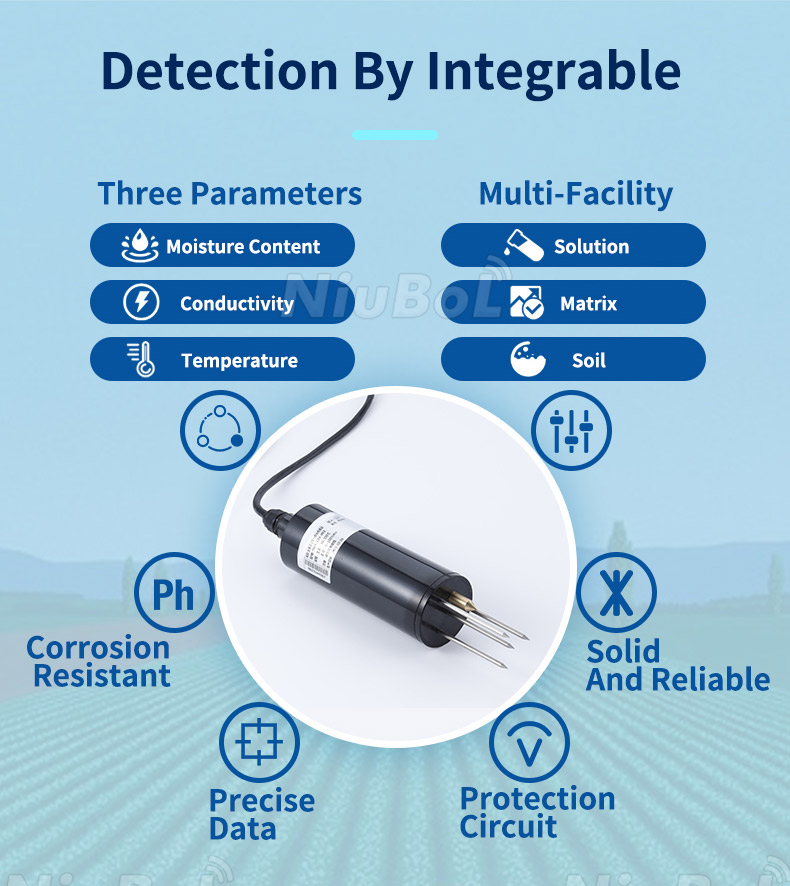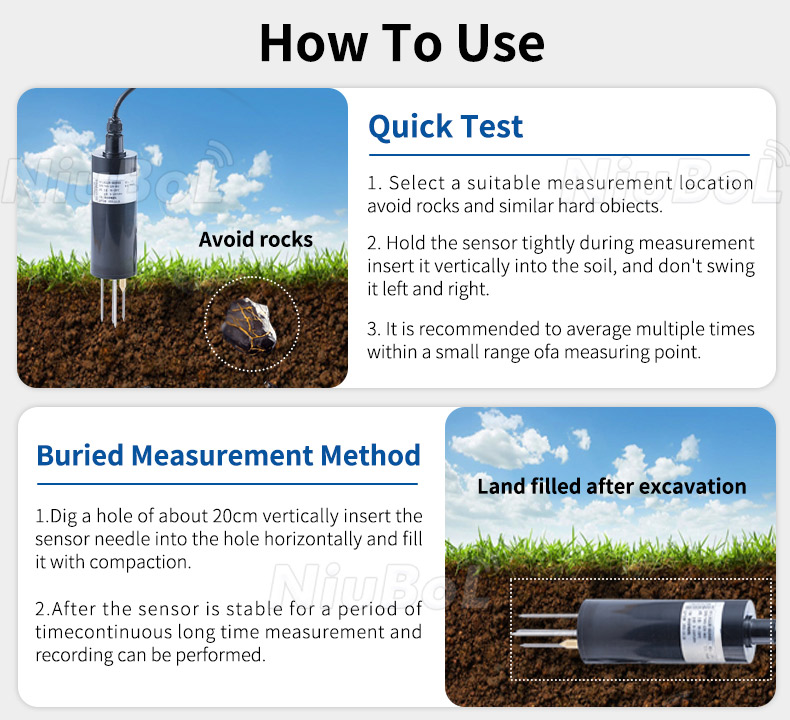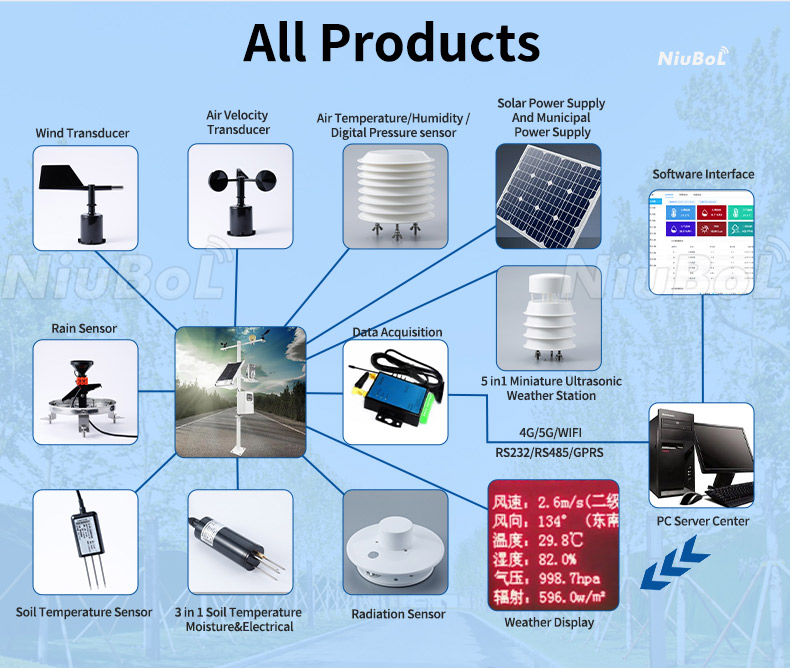

— Blogs —
—Products—
 Consumer hotline +8618073152920
Consumer hotline +8618073152920 WhatsApp:+8615367865107
Address:Room 102, District D, Houhu Industrial Park, Yuelu District, Changsha City, Hunan Province, China
Product knowledge
Time:2024-09-16 20:17:56 Popularity:1227
A soil moisture sensor, also known as a soil water content sensor, is a device specialized in measuring the relative water content of soil. It is widely used in the fields of agricultural irrigation, forestry protection, water-saving agriculture, greenhouses, flower and vegetable cultivation, grassland pasture management, soil snapshot, plant cultivation, and scientific experiments. The soil moisture sensor indirectly determines the soil moisture condition by measuring certain physical parameters of the soil, such as dielectric constant, resistance or capacitance.
The principle of operation of soil moisture sensors is usually based on the following techniques:
1. Resistive sensors: moisture content is estimated by measuring the impedance of the soil to an electric current. When the soil is dry, the resistance is high; when the soil is moist, the resistance is low.
2. Capacitive sensors: measure changes in the soil dielectric constant. Changes in moisture content result in changes in the dielectric constant, so moisture content can be estimated by measuring the capacitance.
3. Frequency Domain Reflectance (FDR) sensors: similar to capacitive sensors, they determine moisture content by measuring the dielectric constant between the sensor and the soil. The sensor emits an electromagnetic wave of a certain frequency, and as the wave travels through the soil it is affected by moisture, which changes the frequency of the returned wave.
4. Time Domain Reflectance (TDR) sensors: Determine soil moisture by measuring the time it takes for an electromagnetic wave to propagate through the sensor probe. Waves travel slower in soil containing moisture, so the propagation time is related to the soil moisture content.

The method of reading a soil moisture sensor usually depends on the type of output from the sensor (analog or digital signal) and the reading device used (e.g. microcontroller, data collector, etc.). Here are some common reading methods:
1. Analog sensors:
- Voltage or current output: Use a data logger or a microcontroller with multiple analog inputs to read the sensor's output. For example, a 0-5V voltage signal can be connected directly to the microcontroller's ADC (analog-to-digital converter) input port.
- Via a multimeter: If the sensor output is a voltage signal, a multimeter can be used to directly measure the voltage value, which can then be converted to a soil moisture value based on the sensor's calibration curve.
2. Digital sensor:
- I2C or SPI interface: for sensors with a digital communication interface, the data can be read using a microcontroller that supports the appropriate protocol. This usually involves writing code to initialize the sensor, configure parameters and read data.
- Data Loggers: Some data logger devices can communicate directly with digital sensors without the need for additional microcontroller programming.
3. Direct reading:
- LCD display: Some sensors are equipped with LCD displays that allow soil moisture values to be read directly from the screen.
- Cell phone application: For smart sensors that support Bluetooth or Wi-Fi, the data can be read through a dedicated cell phone application.
4. Using a data collector:
For cases that require connection to a computer or remote monitoring system, a data collector can be used to read data from the soil moisture sensor.
Data collectors usually have multiple input channels that can read data from multiple sensors at the same time and transmit the data to a computer or cloud server either wired or wirelessly.

Reading data from a soil moisture sensor usually requires connecting to a reading device such as a microcontroller (e.g., Arduino), a data logger, or a dedicated reading meter. Below are the general steps for reading a soil moisture sensor:
1. Connect the sensor: connect the output of the soil moisture sensor to the input of the readout device. For sensors with analog outputs, they are usually connected to the analog input pins of the device; for sensors with digital outputs, they are connected to the digital input pins.
2. Initialize the readout device: If a microcontroller is used, a program needs to be written to initialize the sensor readout. This may include setting the pin mode, configuring the ADC (analog-to-digital converter), and so on.
3. Read data: Execute the read command to get data from the sensor. For analog output sensors, the reading is a voltage value, which needs to be calculated by the voltage-to-humidity conversion formula; for digital output sensors, the reading is a digital signal, which can directly represent the humidity value.

4. Processing and displaying data: The readings are processed, converted to percentage humidity or other forms of humidity representation, and displayed on a monitor or stored in a data logger.
5. calibration: to improve the accuracy of the readings, it may be necessary to calibrate the sensor. The calibration process usually involves measuring the output of the sensor under known humidity conditions and adjusting the conversion equation of the reading device to match the actual humidity.
Regardless of the method used, the following points need to be kept in mind when reading soil moisture sensors:
Ensure that the sensor is installed in the correct location to represent the soil moisture conditions in the area to be monitored.
Calibrate the sensor periodically to ensure the accuracy of the measurements.
Select the appropriate reading method and equipment according to the characteristics of the sensor and application requirements.
Summarize:
When reading sensors, it is necessary to refer to the sensor's user manual for information on how to properly connect the sensor, calibrate the sensor (if required), and how to interpret the output signal. Ensure that the power and signal wires to the sensor are correct and that the sensor has been properly installed and calibrated according to the manufacturer's guidelines.
NBL-S-THR-Soil-temperature-and-moisture-sensors-Instruction-Manual-V4.0.pdf
NBL-S-TMC-Soil-temperature-and-moisture-conductivity-sensor.pdf
Related recommendations
Sensors & Weather Stations Catalog
Agriculture Sensors and Weather Stations Catalog-NiuBoL.pdf
Weather Stations Catalog-NiuBoL.pdf
Related products
 Combined air temperature and relative humidity sensor
Combined air temperature and relative humidity sensor Soil Moisture Temperature sensor for irrigation
Soil Moisture Temperature sensor for irrigation Soil pH sensor RS485 soil Testing instrument soil ph meter for agriculture
Soil pH sensor RS485 soil Testing instrument soil ph meter for agriculture Wind Speed sensor Output Modbus/RS485/Analog/0-5V/4-20mA
Wind Speed sensor Output Modbus/RS485/Analog/0-5V/4-20mA Tipping bucket rain gauge for weather monitoring auto rainfall sensor RS485/Outdoor/stainless steel
Tipping bucket rain gauge for weather monitoring auto rainfall sensor RS485/Outdoor/stainless steel Pyranometer Solar Radiation Sensor 4-20mA/RS485
Pyranometer Solar Radiation Sensor 4-20mA/RS485
Screenshot, WhatsApp to identify the QR code
WhatsApp number:+8615367865107
(Click on WhatsApp to copy and add friends)
